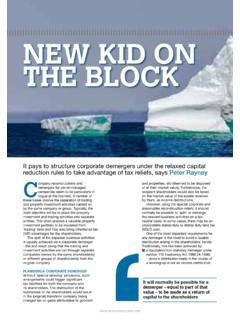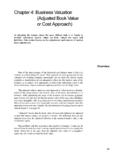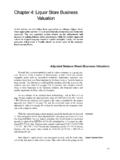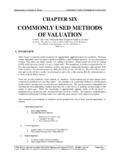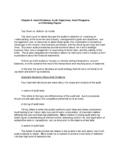Transcription of A MATTER OF GOODWILL O - peterrayney.co.uk
1 Q wildin 8september 2014 accountancy The sale of trading/practice GOODWILL at market value to a new company is a legitimate transaction. Indeed, since the sale is normally being made to a connected party , s17, Taxation of Chargeable Gains Act 1992 (TCGA 1992), deems the transaction to take place at its market value for CGT purposes and it was not so long ago that taxpayers looked to defer this gain rather than pay the CGT. Nevertheless, it is perhaps not surprising that (in recent years) HMRC has begun to look at the supporting GOODWILL valuations more closely to ensure they stack-up commercially.
2 Indeed, many accountants receive letters from HMRC s Shares and Assets Valuation (SAV) office, which run to many pages asking all sorts of wide-ranging questions relating to the economics and underlying profitability of the business , etc. The recent case of Wildin v HMRC [2014] UKFTT 459 (TC), which is discussed below, also illustrates the tenacity of HMRC s SAV office when dealing with GOODWILL valuations on incorporations, especially in relation to professional AND business GOODWILLIn Tax Bulletin 76, April 2005, HMRC sought to draw a distinction between personal and business GOODWILL .
3 HMRC insists that personal GOODWILL , which relates to the personal skills, attributes and personality of a particular individual, is not capable of Over the last decade or so, many tax advisers and accountants have had to dust down their GOODWILL valuation texts. This is largely due to the significant increase in the incorporation of existing businesses and professional partnerships, such as accountants, lawyers, dentists and so on. Furthermore, the vast majority of these incorporations tend to be structured as an asset sale at market value. This sale structure has significant tax advantages.
4 The proprietor/partner sells their GOODWILL to the (new) company at its market value (along with the net tangible assets). In the majority of cases, the company has little or no opening cash funds, so the consideration value of the transferred assets is normally credited to the director s loan account. However, since the capital gain on the GOODWILL would invariably qualify for entrepreneurs relief (ER), it will only be taxed at the beneficial 10% ER capital gains tax (CGT) rate. The proprietor/partner therefore often creates a substantial credit balance on their loan account for the sale value of the GOODWILL at an effective tax cost of 10%.
5 They incur no further personal tax charge on the repayment of their loan account, so this becomes a very efficient method of extracting income from the company. Indeed, there will be a further tax advantage where the original sole trader/partnership firm had started trading after March 2002. In such cases, the corporate intangibles regime permits the company to deduct its annual GOODWILL amortisation for tax purposes. After the Wildin case, Peter Rayney says the value of GOODWILL must be commercially sustainableA MATTER OF 9being transferred to the company. Personal GOODWILL is only likely to be found where the business depends on the special skills and personality of the sole trader, but the same business may have some other GOODWILL value, which is capable of being transferred.
6 On the other hand, free business GOODWILL normally derives from a business s brand or good name, reputation, employee expertise, customers, client base and so on, and is capable of being sold for value. In recent years, HMRC has been particularly resistant to accepting the existence of free GOODWILL where groups or partnerships of medical consultants incorporate their separate private practices. HMRC s typical challenge is that a company cannot carry on a profession. Furthermore, perhaps surprisingly, HMRC has argued that where a company that employs professionals to exercise their profession as employees of the company, it has not succeeded to the practice previously carried on by the professionals in their own right.
7 One final potential trap is the sale of occupational income provisions in chapter 4, part 13, Income Tax Act 2007 (ITA 2007). Under these anti-avoidance provisions, HMRC has the ability to tax capital proceeds as income. Broadly, the rules can be triggered where there are arrangements to exploit an individual s earnings capacity in the course of their occupation with the view to avoiding income tax (s773(2) ITA 2007). They should not therefore apply to commercially driven transactions. Furthermore, the vast majority of incorporation-based transactions should also be exempted from this potential income tax charge under the sale of going concerns exemption in s784, ITA 2007.
8 Notably, HMRC will seek to apply these rules to entertainers and sports people who sell royalty income streams, etc, to connected VALUATIONS WITH SAVSAV clearly seek to establish that GOODWILL valuations used for incorporation sales are not excessive . Thus, when planning the incorporation of a particular business , the golden rule is to make sure that the GOODWILL value used is reasonable and defensible. There is nothing worse than starting negotiations with SAV on the back foot because of an initial over-zealous or fanciful valuation. It is therefore sensible to arrange for a carefully considered GOODWILL valuation report to support the sale value used.
9 Some guidance on GOODWILL valuations is given proprietors/partners may wish to obtain certainty on their GOODWILL valuations when they submit their tax returns by using SAV s post-transaction valuation check service. This would entail submitting a request to SAV on form CG34 for the GOODWILL value to be agreed shortly after the incorporation has been completed. This ought to give sufficient time to agree the valuation for CGT purposes before the 31 January filing date. However, the SAV s post-transaction valuation procedure is not compulsory and some clients It is sensible to arrange for a carefully considered GOODWILL valuation report to support the sale value usedFIGURE 1 GOODWILL VALUATION (CAPITALISED EARNINGS BASIS)Liam and Noel established the O Consultancy in August 1987 and currently operate through a partnership.
10 In recent years, the firm s profitability has considerably increased due to some lucrative contracts. The company s accountant has recently recommended that they incorporate their incorporation will be implemented by a sale of the business and the assets, including GOODWILL , at market value. The firm operates from premises owned by the partners on a rent-free these purposes, the GOODWILL valuation is valued at 700,000, which has been calculated as follows: 000 Assessment of maintainable profits680 Commercial salaries for two partners (including employers NIC)(200)Economic rental charge (50)Interest on capital (say)(30)Adjusted pre-tax profit400 Less: Corporation tax charge @ 20%(80)Maintainable earnings320 Capitalised earnings 320,000 x multiple of 41,280 Less.



